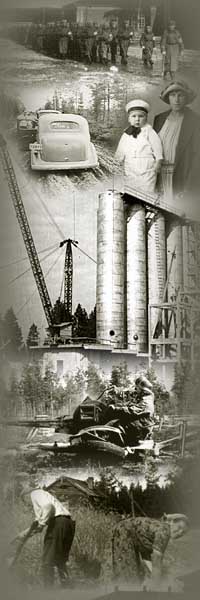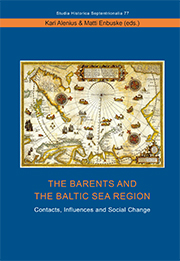 |
 |
|
| Studia Historica Septentrionalia 77 |
| |
Kari Alenius & Matti Enbuske (eds.),
The Barents and the Baltic Sea Region. Contacts, Influences and Social Change
Pohjois-Suomen
Historiallinen Yhdistys, Rovaniemi 2017, 386 s, mv-kuvitus.
|
 |
This book
is based on the papers presented in the “The Barents and the
Baltic Sea region: contacts, influences and social change”
symposium that took place at the University of Oulu on December
10th–11th, 2015. It was an international event organized by the
Department of History and Transcultural Encounters Research Center
(TCERC). The symposium continued series of researcher meetings at the
University of Oulu. These contribute to Arctic and Nordic research,
both of which belong to the university’s focal areas.
The symposium focused on cultural, economic, political, religious,
social and other phenomena that have affected the region and its
relationships with the surrounding world. All in all, the aim of the
symposium was to analyze the characteristics of the Barents and Baltic
Sea region from interdisciplinary perspectives.
Artikkelit / Articles:
Kari Alenius & Matti Enbuske, Approaches to the Study of the
Barents and the Baltic Sea Region
Challenges of cultural and political encounters
Sirpa Aalto, Hyväksikäyttöä vai kumppanuutta? Saamelaisten ja
skandinaavien kohtaamiset islantilaisissa saagoissa
Andrej Kotljarchuk, Nordic Fishermen in the Soviet Union: Ethnic
Purges and the Cleansing of the Cultural Landscape
Saulius Kaubrys, Legal regulation of the status of local authorities in Lithuania in 1918–1940: addressing the challenges
Dalia Bukelevičiūtė, Accessibility of Education and Social Aspects in Lithuania in the Period of 1936–1940
Lars Elenius, Ethnopolitical mobilisation in the North Calotte area
Otso Kortekangas, Whose history is Sámi history? Utility, nation-
state and the indigenous studies paradigm – a historiographical
comment
Trans-border perspectives
Olavi K. Fält, Globaali sota: Itämeren alue Venäjän–Japanin sodan
(1904–1905) aikaisena kulttuurisena kohtaamispaikkana
Matti Enbuske,
Pohjois-Suomen siirtolaisuus Ruijaan ja Pohjois-Amerikkaan:
määrä, lähtöalueet, sosiaalinen tausta
sekä vertautuminen Pohjois-Ruotsiin
Thomas Lundén, Border towns in the Barents – Baltic area:
Temporal and spatial characteristics
Andrey Repnevskii,
25 years of collaboration between Russian and Norwegian historians:
positive results. Joint research projects and publications in their
respective languages in the period 1991–2015
Oksana Zaretskaya, The Development of Cooperation in the Baltic
and the Barents Regions: Russian-Scandinavian Relations
Northern maritime dimension
Ritva Kylli, Borderlands for the Benefit of the Empire: Alcohol,
the Fur Trade and the Native People of the North
Outi Korhonen, Hailuotolaisten Tukholman purjehdukset
1700-luvulla
Juha Sahi, Kauppalaivuriverkosto
Itämeren äärellä: Tapaustutkimus livuri Fredrik
Henriksson Anttooran kauppa- ja rahdinkuljetus-verkostosta Tukholmaan
1800- ja 1900-luvun vaihteessa
Masataka Tamai, The Barents Sea and Japan: Rethinking the
relationship through the North Sea Route
Juha Saunavaara,
Commercial utilization of the Northern Sea Route and regional
development policy – Hokkaido as a case study
Christophe Buyle, “Fennoscandia wave”: Zone of Contact Fostering Trans-Regionalism
Representations in transition
Jukka Nyyssönen, Väinö Tanner and the idea of Fennoscandia –
building planetary zones of contact
Esa Ruuskanen, Napa-alueet suomenkielisissä aikakausi- ja
sanomalehdissä 1870–1910: rajaseudun haltuunotto,
havainnollistaminen ja hyöty
Samu Sarviaho, Suomalaista
itsetuntoa ja heimoaatetta rakentamassa – Karjalan
varhaishistorian ja keskiajan historiakuvan muodostuminen 1800-luvun
suomalaisessa historiankirjoituksessa
Juho Niemelä, Isänmaan kuvasta luonnon laboratorioon – Suomen kansallispuistokeskustelun varhaisten puheenvuorojen vaihtuvat
näkökulmat
Kari Alenius, A distant negligible Baltic country: The image of
Lithuania in Finnish schoolbooks
|
 |
 |
|